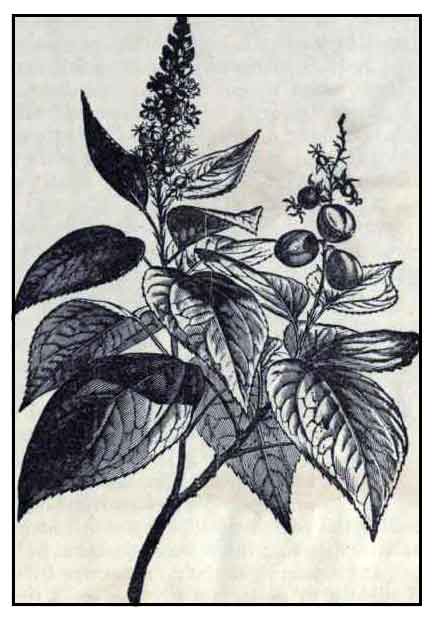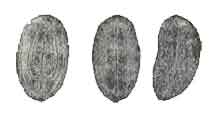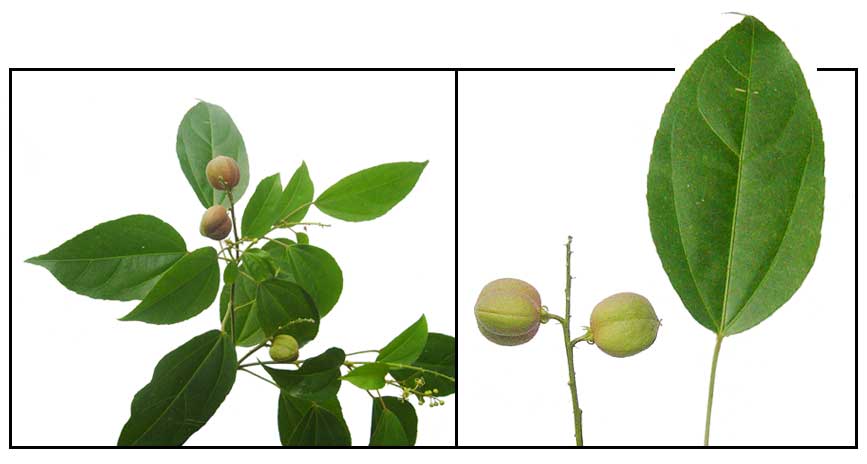|
Botany
Tuba is an erect
or more or less spreading shrub or very small tree. Leaves are alternate, ovate 7 to 12 centimeters in length, usually somewhat
rounded at the base, pointed at the tip and toothed at the margins.
Flowers are very small, borne on terminal inflorescences, with
the female flowers situated toward the base of each inflorescence. Fruits is a capsule, ellipsoid or obscurely 3-angled, 1.5 to
2 centimeters long and contains a single seed. Seeds are ovoid or oblong, 12 to 15
millimeters in length and 3-angled, the testa dark-brown or blackish, thin and
brittle and of faint odor; the albumen and the embryo are yellowish.
Seeds are at first mild in taste and subsequent acrid and pungent.
 Distribution Distribution
- Usually planted, in and
about towns, throughout the Philippines
- Naturalized in some places.
- Of prehistoric introduction from Malaya.
- Also occurs in India to New Guinea.
Constituents
- Roots contain tannin, 65%.
- Seeds have a fixed oil (croton oil), 30-56%, containing croton globulin and croton albumin, arginine, and lysine; alkaloid ricinine (toxic); lipase; invertase, amylase, raffinase; proteolytic enzyme, crotone resin, tiglic acid, croton oleic acid, stearic, palmitic, myristic, lauric, oenanthrallic, capronic valerianic, butyric, isobutyric, acetic and formic acids; tannin, 65%.
- Chemical analysis of seeds yielded eight new phorbol esters (three phorbol diesters, 1-3, and five 4-deoxy-4α-phorbol diesters, 4–8), together with 11 known phorbol diesters (nine phorbol diesters, 9–17, and two 4-deoxy-4α-phorbol diesters, 18 and 19). (see study below) (16)
- Leaves yielded two new compounds, badounoids A and B, together with 13 known norsesquiterpenes.
(19)
- GC-MS study of ethanolic extract of leaves yielded 41 compounds, with major compounds of glycoside, phenolic, palmitic acid, terpene alcohol, polyenoic fatty acid, phytol ester and phytoesterol.
(32)
- Study of seeds isolated seven compounds
elucidated as bis(2,3-dihydroxypropyl) nonanedioate (1), 12-O-(α-methyl)butyrylphorbol-13-decanoate (2), 12-O-tiglylphorbol-13-decanoate (3), (9S,10R,11E,13R)-9,10,13-trihydroxyoctadec-11-enoic acid (4), methyl (9S,10R,11E,13R)-9,10,13-trihydroxyoctadec-11-enoate (5), 4(1H)-quinolinone (6), and 5-hydroxy-2-pyridinemethanol (7). (see study below) (36)
Properties
- Oil is yellow, orange, or brown, according to age.
-
Pungent and burning taste, warming, antipyretic.
- Nauseating odor.
- Toxic in excessive internal use.
- Roots, bark, leaves, and seeds possess drastic purgative properties.
- Croton oil is considered rubefacient and counterirritant.
- Croton oil's property as external vesicant and internal purgative is attributed to the presence of croton oleic acid.
- Differentiation between croton poisoning from ptomaine poisoning: In croton poisoning, pain is felt at the back of the throat, sometime after the poison has been swallowed. Pain is also felt at the anus. Also, croton poisoning is immediately relieved by doses of bismuth, not so with ptomaine poisoning.
Parts
utilized
· Roots, seeds, fresh leaves.
 Uses Uses
Folkloric
· For rheumatic
pains of the legs and waist: use 3 to 6 gms of dried material in the
form of decoction.
· Pounded fresh leaves may be applied as poultice for snakebites
or may be used as insecticide.
· Poultice of leaves applied or rubbed on area of snake and insect bites.
· For sprains and bone pains: Oiled leaves or bark material are
heated and applied to painful areas.
· Croton seed oil has been used as purgative.
· Seed oil used for treatment of schistosomiasis and other intestinal parasites.
· Roots, bark, seeds, and leaves considered a drastic purgative.
· Bruised root applied to carbuncles and cancerous sores.
· Testa used for fluxes.
· In Annam, bark used as a tonic.
· In Java and Kelantan, roots are finely shredded, mixed with water, and drunk by women as abortifacient.
· Diluted tincture of croton seeds used as a stimulant and applied in certain cutaneous affections, like eczema, ichthyosis and erythema.
· Seeds, while half-roasting over a lamp or candle flame, is inhaled through the nostril to relieve asthma.
· Croton oil is rubbed on the skin as rubefacient and counterirritant.
· Internally, croton oil us used as a powerful hydragogue, cathartic, and purgative. In excessive doses, it can cause severe purging, collapse and death.
 · Liniment used as stimulant and applied to chronic rheumatism, neuralgia, glandular and other indolent swellings, chronic bronchitis and other pulmonary affections. · Liniment used as stimulant and applied to chronic rheumatism, neuralgia, glandular and other indolent swellings, chronic bronchitis and other pulmonary affections.
· Croton oil is used in dropsy, obstinate constipation, intestinal obstructions, and lead poisoning; as a preliminary laxative in leprosy; and as a revulsive in apoplexy. A few drops at the base of the tongue produces catharsis.
· As a blister, applied to the scalp in acute cerebral diseases, to the cord in spinal meningitis, to the chest in chronic bronchitis, and to the throat in laryngitis. Used in lock-jaw and mania.
· In Ayurveda, considered purgative; known as Kumbhini, used in the treatment of constipation after Sodhana (detoxification process) of seeds with Godugdha (cow's milk). (15)
- In Unani medicine, Croton tiglium seeds and Zingiber officinalis rhizome extract has been used in equal ratio as a paste formulation for the treatment of Safa (alopecia areata). (17)
Others
· Fish and Arrow Poison: Plant is universally used as fish poison. Pounded ripe fruit is used in Java and by the Dayaks of Borneo to poison fish. In the Philippines, fruit or crushed leaves are similarly used. The leaves are one of the constituents of the Batak arrow poison. The Arbor arrow poison of the northeast frontier Assam is a paste believed to be made from pounding soft plant parts. When seeds are used, they are pulverized, put in sacks, and placed in ponds or rivers.(•) C. tiglium is widely used in fish poisoning by the tribal people of Arunachal Pradesh, India. (32)
Croton-Phenol Peel
· Minute quantities of croton oil with phenol as solvent, diluted in water and saponified has been used as a peeling agent. The mechanism of interaction between oil and skin continues is yet to be fully explained. (8)
Studies
• Purgative / Laxative:
A study of the ethanol extracts of three
Chinese medicinal plants —Croton tiglium (Badou) , Rheum palmatum
(Dahuang) and Cannabis sativa (Huomaren)— known for their laxative
properties, showed an effect on the rat intestinal epithelial cells
providing evidence for the pharmacologic mechanism on the intestinal
tract. (1)
• Laxative: An Indonesian study on an ethanol extract of seed showed laxative properties.
• Purgative / Laxative: Study of a 50%^ EtOH extract of dried nuts showed a dose-dependent cathartic effect in albino rats. Results suggest a purgative effect probably through a increase in gut motility via muscarinic receptor activation.
• Tumor-Enhancing / Seeds:
A 1965 study isolated 2 active co-carcinogenic agents from
the seed of CT. Both were potent cocarcinogens at very low dosage. Phorbol
myristate acetate, a semisynthetic compound from the croton resin, showed
promoting activity. (2)
• Tumor-Enhancing Principles:Study of active fractions of croton resin showed a high incidence of malignancy and low incidence of tumor regression. Alone, croton resin gives rise to a very few tumors; croton oil elicits low incidence of malignancy. In contrast, croton oil elicits a low incidence of malignancy, a markedly higher incidence of tumor regressions, and applied alone is notably tumorigenic. (3)
• Gastrointestinal
Motility Modulation / Oil: Study showed Croton tiglium oil
might modulate gastrointestinal motility and induce intestinal inflammation related to immunological milieu and motor activity. Results highlight its folkloric
use in gastrointestinal disorders. (4)
• Anti-HIV Phorbol Ester / Seeds: A methanol extract of seeds of Croton tiglium yielded five phorbol diesters, together with three known ones. Study evaluated the compounds ability to inhibit an HIV-induced cytopathic effect (CPE) on MT-4 cells and to activate protein kinase C (PKC) associated with tumor-promoting action. 12-O-Tetradecanoylphorbol-13-acetate (TPA) was found to be not only the most potent inhibitor of HIV-1-induced CPE (IC100 value of 0.48 ng/ml), but also the most potent activator of PKC (100% activation at 10 ng/ml). (5)
• EBV-Inducing:
TPA, a tumor-promoting agent, 12-0-tetradecanoyl-phorbol-13-acetate,
was isolated from the seeds and stalk of Croton tiglium. Study has shown
it to be a potent EBV-inducer in vitro while also decreasing EBV-specific
cellular immunity and enhancing EBV-induced transformation.
• EBV-Inducing / Combined Extracts:Combined usage of oily extracts from C tiglium, E lathyris and E tirucalli exerted a marked induction of EBVirus-associated early (EA) and viral capsid (VCA) antigens in genome-carrying human lymphoblastoid cell lines with implications in EBV-associated diseases. (7)
• Antifungal / Antibacterial: Study isolated a novel antimicrobial protein from the seed of Croton tiglium. The protein was found to possess a strong and broad spectrum antimicrobial activity. (9)
• Insecticidal / Anti-Termite / Croton Oil: A home study of Croton oil from leaves mixed with ethyl alcohol showed anti-termite effects and suggests a non-toxic environment-friendly alternative to termite control. (11)
• Antinociceptive / Smooth Muscle Relaxant: Study in mice evaluated the seed of C. tiglium (SCT) for antinociceptive activity with a dose-dependent effect in a writhing test, although weak when compared to aspirin. Study on spontaneous smooth muscle contractions of isolated rabbit jejunum showed the C. tiglium possessed spasmogenic and spasmolytic properties. (13)
• Toxicity and Detoxification of Seeds / Sodhana: Toxicity of C. tiglium seeds may be due to the presence of phorbol esters and crotonic acid along with other constituents. The toxic components may be removed by cow milk during process of Sodhaba, a purification process that decreases the toxicity of C. tiglium seeds. (15)
• Cytotoxic Phorbol Esters / Hepatic Tumor Cell Line: Chemical analysis of seeds yielded eight new phorbol esters, together with 11 known phorbol diesters. Cytotoxicity was evaluated against the SNU387 hepatic tumor cell line, and compound 3 showed the most potent activity. (16)
• Combined Paste Formulation of C. tiglium and Z. officinalis for Alopecia Areata: - In Unani medicine, Croton tiglium seeds and Zingiber officinalis rhizome extract has been used in equal ratio as a paste formulation for the treatment of Safa (alopecia areata). This case study reports on a patient with Safa treated with the Unani herbal drug formulation and significant regrowth of hair was noted. (see folkloric use section above) (17)
• Insecticide: Out of ten plants screened for efficacy as eco-friendly insecticide, Leea sambucina and Croton tiglium were the most effective. (20)
• Anti-Dermatophytic: Dermatophytosis is caused mainly by genera of Trichophyton, Epidermophyton, and Microsporum. Study evaluated the antidermatophytic activity of stems, leaves, and seeds of Croton tiglium against Trichophyton mentagrophytes, T. rubrum, and Epidermophyton floccosum. Oleic acid and hexadecanoic acid were the major components of the stem extract that demonstrated strong anti-dermatophytic activities. The ethanolic extract of stem or seed exhibited strong antidermatophytic activities and can be considered for antifungal application after appropriate processing. (21)
• Apoptosis
in Human Lung Cancer A549 Cells Via Bax/Bcl-2 Pathways: Study investigated the effect of Croton tiglium extract on cellular proliferation and apoptosis in non-small cell lung cancer cell line (A549) in vitro. Results showed inhibition of A549 cell proliferation in a dose- and time-dependent manner and promotion of apoptosis through Bac/Bcl-2 pathways. (22)
• Toxic Proteins / Pro-Inflammatory Effect: Study determined the toxic targets of proteins from C. tiglium and investigated the potential mechanism of their toxicity. Oral medication of croton proteins caused significant gastrointestinal damage with edema and diarrhea. Toxic reactions of the crude protein were associated with inflammation. In vivo, the crude protein caused release of inflammatory mediator PGE2 in mice by intraperitoneal injection. In vitro, pro-inflammatory cytokines, including TNF-a and IL-1ß were produced in macrophages in a dose- and time-dependent manner. In clinical applications, effective components of C. tiglium frequently coexist with toxic ingredients, including croton oil and protein, that may cause gastrointestinal toxicity, which may have a synergistic effect. (23)
• Antioxidant Efficiency of Seeds Incorporated with Ag Nanoparticles / Increased Cytotoxicity Against Colon Cancer Cells: Study aimed to enhance the efficiency of C. tiglium seed extracts by incorporation with silver nanoparticles through raised cytotoxicity against growth of human colon cancer cells. Seed contained phytoconstituents i.e., carbohydrates (glycosides), flavonoids, sterols (triterpenes), alkaloids, and proteins. Incorporation of AgNPs into the extract caused no toxicity on test animals. Median lethal doses (LD50) of ethanolic, PE, and aqueous seed extracts Ag nanocomposites were 7.95, 5.2, and 65 ml/kg, respectively. Incorporation of AgNPs into different extracts enhanced the antioxidant properties through increasing of total antioxidant capacity, total reducing power, and free radical scavenging activity. Nanoparticulated extracts exhibited elevated cytotoxicity against growth of human colon cancer cells. (24)
• Alternative
Biodiesel Source / Extraction and Esterification / Seeds: An alternative for fuel reserve is the use of biodiesel from C. tiglium oil seed feedstock. Study determined the optimum process conditions for producing the highest extract yield and quality biodiesel from seeds. Study reports on maceration time, material/solvent ratio, and extract yield. The oil quality of C. tiglium seed is good for biodiesel material based on value of density, kinematic viscosity, total glycerin, iodine, and saponification. (25)
• Anticonvulsant / Seeds: Study evaluated the anticonvulsant effect of hydroalcoholic seed extract of Croton tiglium in rats and mice in seizures induced by ECM and pentylenetetrazole. Sodium valproate was used as standard. Results showed dose dependent anticonvulsant effect in electrically induced seizures, with only minimal protective effect in PTZ-induced seizures. (26)
• Toxic Effects of Crotocaudin / Molluscicidal / Stem Bark: Crotocaudin extracted from C. tiglium was evaluated for toxicity to freshwater vector snail Lymnaea acuminata and Fasciola gigantica which cause immense harm to man and his domestic animals. Study suggest that the extracted compound crotocaudin may be used as a potent source of molluscicides. Plant products are less expensive, easily available, easily soluble in water, and safer for non-target animals than synthetic molluscicides. (27)
• Acute and Subchronic Toxicity Studies / Seeds: Study evaluated the acute and subchronic toxicity of Tiglium seed extract in rats after oral administration using OECD guidelines. Single oral dose up to 2000 mg/kg of seed extract resulted in no mortality of abnormal clinical signs. In 13-week toxicity study, the extract exhibited no dose-related changes (mortality, body weight, hematology and clinical biomarkers, and histopathology) at dos3 of up to 500 mg/kg. Results suggest the seed extract appears to be safe for human consumption. (28)
• Biochemical and Hematological Effects of Mixing Seeds with Animal Diet: Study evaluated the toxic effects of C. tiglium seeds mixed with animal diet on plasma and blood parameters in male albino rats. Results showed croton seeds administration at doses of 10% and 20% have little effect on some hematological indices, especially those relating to RBCs and WBCs. (29)
• Antitermitic / Seeds: Study evaluated the antitermitic potential of seed extracts of Withania somnifera (Indian ginseng), Croton tiglium (jamalgoota) and Hygrophila auriculata (talimkhana). The seed extracts caused changes in tunneling behavior, number of bacterial colonies in hindgut and activities in midgut of Odontotermes obesus. C. tiglium showed the lowest LT50 (12.85 and 2.65 h) among the three seed extracts at 50% concentration, and 100%, respectively. (30)
• Phorbol Ester-Type Diterpenoids / Weak Cytotoxicity Against Cancer Cell Lines: Study of ethanol extract of twigs and leaves isolated two new phobol esters (1 and 3) and seven known ones (3-9). The compounds were evaluated for cytotoxic activities on human cancer cell line A549. Compounds 3 and 7 showed weak activities. (31)
• Induction of Apoptosis in Human Lung Cancer A549 Cells: Study demonstrated that Croton tiglium extract could inhibit the proliferation of A549 cells by regulating apoptosis in vivo. It has potential to provide biologically active compounds for treating NSCLC and deserves consideration as new plant-derived anticancer agent. (33)
• Treatment of Alopecia Areata /
Herbal Preparation of Croton tiglium and Zingiber officinalis: An herbal preparation for local application was prepared as a paste in 1:1 ratio of powdered Jamal gotta (Tiglium tiglium) and Adrak (Zingiber officinalis). The paste was applied on area of alopecia areata, once daily before going to bed, for one month. Regrowth of white hairs was marked on the 10th day of treatment. White hairs gradually turned almost completely black after 45 days. (34)
• Anti-Fertility
/ Seeds: Study investigated the aiti-fertility and anti-implantation properties of C. tigilum seeds on female albino rats. At 200 mg/kbw daily for a week, ethanol extract of Croton seeds was 100% effective in preventing implantation sites in uterine horn of female animals. The endometrium may be histopathologically affected to decrease contact and adhesion between blastocytes and uterine epithelium. (35)
•
Cytotoxicity Against Human Lung Cancer Cell Line / Seed: Study of seeds isolated seven compounds. Compounds 2 and 3 showed cytotoxicity against human lung cancer cell line A5449 with IC50s of 47.8 and 7.0 µmol/L, respectively. (see constituents above) (36)
• Anti-Obesity Effects of Gambi-Hwan: Gambi-hwan in a mixture of herbal drugs: bitjis martensi kirsch (Chinese scorpion) and Croton tiglium (Badou). Study evaluted the anti-obesity effects of Gambi-hwan extract on obese rats induced by high-fat diet through expression of UCP-1 and PPAR-delta. Results indicated Gambi-hwan extract upregulated the expression of UCP-1 and PPAR-d in adipose tissue, which may contribute to reducing the weight of adipose tissue. (37)
• Brine Shrimp Toxicity Study: Study evaluated 23 Bangladesh medicinal plants used in traditional medicine for brine shrimp lethality toxicity. Of the 23 plants, 80% were toxic to brine shrimp (LC50 < 30 g/ml). Among all extracts, the methanolic extract of Croton tiglium exhibited highest toxicity to brine shrip (LC50=0.0924 g/ml). Vincristine sulfate was used as reference standard. (38)
Availability
- Wild-crafted.
- Croton seeds, fruit, tinctures and oil in the cybermarket.
|



![]()

